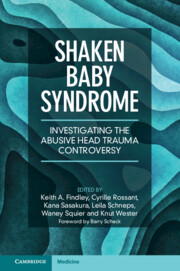Book contents
- Shaken Baby Syndrome
- Shaken Baby Syndrome
- Copyright page
- Dedication
- Contents
- Foreword
- About This Book
- Abbreviations
- Section 1 Prologue
- Chapter 1 Maintaining the Orthodoxy and Silencing Dissent
- Chapter 2 The History of Shaken Baby Syndrome
- Section 2 Medicine
- Section 3 Science
- Section 4 Law
- Section 5 International
- Section 6 Postface
- Appendix: Frequently Repeated Claims concerning Shaken Baby Syndrome
- Index
- Plate Section (PDF Only)
- References
Chapter 2 - The History of Shaken Baby Syndrome
from Section 1 - Prologue
Published online by Cambridge University Press: 07 June 2023
- Shaken Baby Syndrome
- Shaken Baby Syndrome
- Copyright page
- Dedication
- Contents
- Foreword
- About This Book
- Abbreviations
- Section 1 Prologue
- Chapter 1 Maintaining the Orthodoxy and Silencing Dissent
- Chapter 2 The History of Shaken Baby Syndrome
- Section 2 Medicine
- Section 3 Science
- Section 4 Law
- Section 5 International
- Section 6 Postface
- Appendix: Frequently Repeated Claims concerning Shaken Baby Syndrome
- Index
- Plate Section (PDF Only)
- References
Summary
Shaken baby syndrome (SBS) is a determination, typically made by physicians, that a child or infant has been violently shaken whenever three findings are present (subdural and retinal haemorrhage, and brain swelling or dysfunction) and there is no history of major trauma or a fall from multiple stories. These beliefs serve a forensic purpose: they permit physicians and law enforcement to identify abuse in a non-verbal child where the parents or caretakers deny abuse. Globally, thousands of parents and carers have been convicted or had children taken away based on an SBS determination. Shaken baby syndrome, however, has become controversial and many of its foundational tenets have been challenged and proven unreliable. For nearly two decades, paediatric physicians and child abuse prosecutors have defended the SBS determination, while challengers continue to question its reliability in the courts, where judges and juries must sort out its reliability on a case-by-case basis. This chapter chronicles SBS’ history, as that history is helpful to understand the concerns and controversies about the hypothesis.
Keywords
- Type
- Chapter
- Information
- Shaken Baby SyndromeInvestigating the Abusive Head Trauma Controversy, pp. 11 - 32Publisher: Cambridge University PressPrint publication year: 2023

